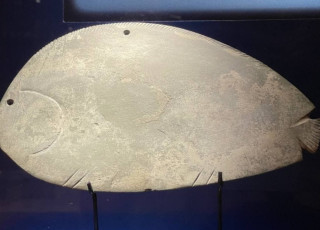Discovering Tutankhamun: The Boy King and The Lost Tomb
By Olivia Barney
We owe a lot to the great minds of ancient Egypt. In addition to giving us innovative beauty products, iconic mythology, and architectural wonders like the Sphinx and Pyramids at Giza, the Egyptians also produced some of the earliest philosophers and scientists, developed the postal system, and were the first people to use toothpaste. (Yes, you can thank the Pharaohs for your pearly whites!)
From King Khufu to Cleopatra, the ancient Mediterranean kingdom has remained a steady fixture of fascination around the world — an obsession so enduring that it’s been labeled as “Egyptomania.” When new sites are discovered, or when research unveils additional insight into this older world, it’s almost always followed by a surge of renewed interest in ancient Egyptian history. Creature-feature films explore the horrors of a mummy’s curse. Adventure novels follow treasure-hunter protagonists seeking to uncover lost tombs. News outlets promise exclusive content about recent discoveries found at these ancient sites.

Egyptian tomb wall-painting, circa 1826
We’ve seen this surge of Egyptomania time and time again, but perhaps never more dramatically than after the discovery of King Tutankhamun’s tomb in 1922. Whether it was the groundbreaking discovery itself that caught the world’s attention or the mystery shrouding the young king’s life, we can’t be sure. But either way, the find filled the world with a curiosity so powerful that it could flood the Nile.
Who was Tutankhamun? Why did the world care so deeply about discovering his tomb? While there’s likely dozens of reasons, the most compelling answer can be boiled down to simple human interest: the rise and fall of King Tut is a great story.
Who Was Tutankhamun?

Tutankhamun, also known as “King Tut” or “The Boy King,” rose to power in the 18th Dynasty of ancient Egypt, around 1336 B.C. His reign began at the age of only nine years old, following the death of Akhenaten, a radical leader who turned away from the traditional gods of Egypt to worship only one being, a sun god named Aten. Akhenaten’s rule was controversial, and not just because of his radical religious beliefs. It was also in direct conflict with Ma’at, a principle of governance that valued order and steadiness. The ancient Egyptian adherence to Ma’at is thought to be one of the reasons why the civilization endured for so long. Never making radical changes or disrupting the careful balance of things ensured that peace and harmony could thrive. When Akhenaten uprooted their system of worship, he disrupted the law of balance, a law that Pharaohs were under obligation to uphold.
After Akhenaten’s death, The Boy King ruled for a relatively short period of time, just nine years. He passed away when barely older than a child, a teenager who’d lived the life of a king. His reign reestablished the worship of traditional gods and the use of temples — restoring balance across Egypt. Still, while this decision was appreciated by the people, it was another big change that violated Ma’at.
After King Tut’s death, the memory of his time on the thrown was all but erased. His association to his father, Akhenaten, along with the general upheaval both of their reigns caused, led to Tut’s name and image being removed from many records and temple sites. This attempt at erasure is part of what made locating King Tut’s tomb so difficult — but it’s also what saved his tomb from being looted.
The Hunt for the Lost Pharaoh
In the early 20th-century, Egyptologists who sought to study the tombs of ancient Pharaohs faced a harsh reality. Most of the tombs dedicated to wealthy and prominent individuals had already been discovered, their contents stolen and sold. The chances of finding a royal tomb that was still intact were extremely unlikely.

Portrait of Howard Carter
But British archaeologist, Howard Carter was persistent and optimistic. Sponsored by George Herbert, the 5th Earl of Carnarvon, Carter and his team systematically searched the Valley of the Kings, the burial site for Pharaohs past. They were searching for the tomb of a lesser-known king named Tutankhamun.
The work was grueling. For five years, Carter and his team moved an estimated 200,000 tons of rubble under the sweltering Egyptian sun. They found nothing.
In June of 1922, Lord Carnarvon was prepared to give up on their quest and told Carter he was going to stop funding his work. But Carter felt certain they were close and convinced Lord Carnarvon to give them one final season of digging. By the time Carter returned to Luxor in late October, he was nearly out of time and money. Seven days later, on November 4, 1922, Carter’s team made a chance discovery that changed history.
The Discovery of Tut’s Tomb
One of Carter’s crew members found the entrance. His name has since been lost to history, but his influence endures. Stumbling upon a carved stone, he and Carter identified it as a step — the first step leading down to a buried tomb. Carter recorded the moment in his journal with just five simple words: “First steps of tomb found.”

The unbroken seal on Tutankhamun's tomb.
The next day, the crew excavated twelve steps which led to the entrance of the tomb. The doorway was covered in Pharaonic seals, indicating that this was indeed a royal tomb. Most shocking of all, the seals were unbroken, indicating that Carter’s team had discovered an intact tomb.
Carter sent word to Lord Carnarvon who arrived by the 23rd. By the next day, the team had exposed more of the tomb, finding seals that dedicated the space to Tutankhamun, the Boy King. As the excavation continued, Carter’s team followed a sloping passage to a space more than 20 feet underground. The space featured another sealed doorway bearing Tutankhamun’s name. Making a small hole in it, Carter held up a candle and peered inside.
What he saw was magnificent: golden beds, disassembled chariots, and decorated thrones. It was wonderful — more than 5,000 treasured objects found laid to rest with the king. Later, Carter described the moment of discovery this way.

Shrine of Anubis found in King Tut's tomb.
“At first I could see nothing, the hot air escaping from the chamber causing the candle flame to flicker, but presently, as my eyes grew accustomed to the light, details of the room within emerged slowly from the mist, strange animals, statues, and gold — everywhere the glint of gold.”
Aside from the treasure, the team later discovered the Pharaoh himself, and the image of his golden death mask has become a global icon — through the discovery, King Tut’s likeness became the image most associated with the ancient kingdom. It also became the fuel for a pop culture phenomenon. Suddenly, clothing, jewelry, playing cards, and even cigarette cases bore “Egyptianized” designs: rich golds with symbols of palm trees, pyramids, and scarabs.
The Aftermath: Egyptomania & Lasting Impact
The media frenzy endured. Tutankhamun’s fame skyrocketed, and the mystery surrounding his life and death led to wild speculation. Soon, the world’s fascination with ancient Egyptian art and design turned to frightening tales of a mummy’s curse and film franchises capitalizing on the sensationalized stories.
This wave of Egyptomania had a lasting impact on the public perception of the ancient empire, but it also changed the field of archaeology. With the discovery of King Tut came a greater emphasis on conservation, detailed recording, and the importance of public exhibition of the found artifacts. Today, ongoing scientific study utilizes CT scanning of remains and digital mapping of archaeological sites to help preserve artifacts.

Here in Utah, the cultural impact of Tutankhamun continues to endure. Architecture across Utah nods to the Egyptian Revival, like at the Salt Lake Masonic Temple, Peery’s Egyptian Theater in Ogden, or the Egyptian Theatre in Park City. In 2021, the Natural History Museum of Utah hosted a blockbuster special exhibition, Egypt: The Time of Pharaohs. The BYU Museum of Art hosted Art of the Ancient Mediterranean World: Egypt, Greece, Rome in 2004. Public libraries across the state host Egyptian-themed craft and story times.
Utah residents, like the rest of the world, are fascinated with ancient Egypt — a civilization that brought innovation and invention that continues to this day. And the discovery of King Tut’s tomb over 100 years ago, reminds us that curiosity and perseverance remain at the heart of scientific inquiry.




